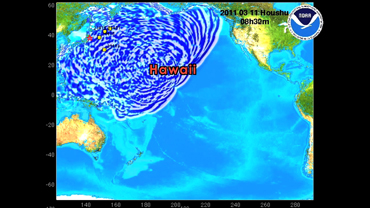Transcript
NARRATOR:
80 miles east of Japan, a 9.0 magnitude earthquake rocks the ocean floor.
This disturbance causes a transfer of energy from the seafloor to the ocean, generating a series of ocean waves, known as a Tsunami.
In about 20 minutes, waves strike the Japanese coastline.
Other nations go on high alert, because the tsunami will propagate, or spread, throughout the Pacific Ocean.
As the tsunami radiates outward from Japan, it encounters a variety of ocean features, such as ridges and underwater volcanoes, which guide the tsunami and create a complex pattern of scattering and reflective waves.
In eight hours, the waves reach the Hawaiian Islands, and in 9 1/2 hours they hit the west coast of the United States. In 16 hours, the tsunami reaches the Indian Ocean and New Zealand. And by 22 hours, the entire Pacific Ocean had been affected.
The impact of a tsunami can be highly variable because of the complicated interactions with ocean features and coastline elements. Wave height and speed will differ from place to place.
Since tsunamis can be hundreds of miles long and travel thousands of miles away from where they originated, they are considered a worldwide threat when they form.
 An official website of the United States government.
Here's how you know we're official.
An official website of the United States government.
Here's how you know we're official.







